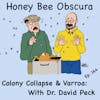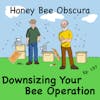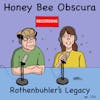Transfers and Cutouts (151)

Beekeeping is not always as straightforward as hive inspections and honey extraction. When bees decide to set up shop in places beyond the traditional hive box, it requires specialized techniques and knowledge to safely and ethically relocate them....
Beekeeping is not always as straightforward as hive inspections and honey extraction. When bees decide to set up shop in places beyond the traditional hive box, it requires specialized techniques and knowledge to safely and ethically relocate them.
When beekeepers set up plain boxes (not the standard Langstroth hive with moveable frames) then move them to a standard hive, it is often called a 'transfer'. When honey bees are removed from a structure, such as the wall of a house, it is called a 'cutout'.
In today's episode, Jim talks about how transfers are not that common these days, and how cutouts are. These are specialized activities that require more than beekeeping skills.
Listen today as Jim tackles the topic of Transfers and Cutouts.
______________________

Thanks to Betterbee for sponsoring today's episode. Betterbee’s mission is to support every beekeeper with excellent customer service, continued education and quality equipment. From their colorful and informative catalog to their support of beekeeper educational activities, including this podcast series, Betterbee truly is Beekeepers Serving Beekeepers. See for yourself at www.betterbee.com
______________________
Honey Bee Obscura is brought to you by Growing Planet Media, LLC, the home of Beekeeping Today Podcast.
Music: Heart & Soul by Gyom, All We Know by Midway Music, original guitar music by Jeffrey Ott
Cartoons by: John Martin (Beezwax Comics)
Copyright © 2023 by Growing Planet Media, LLC

Episode 151 – Transfers and Cutouts
[music]
Jim Tew: Hello, Obscura beekeepers. I'm sitting here just thinking about bees and pondering in this solo segment, trying not to live in the past, but at the same time, having lived in the past, seeing some of the changes that have come along. Even though it's probably the worst time of the year to consider this concept of transferring bees, when is a good time to talk about it? If you don't mind, I'd like to spend a few minutes discussing the evolution of transferring bees. You probably call them cutouts, and how that process has changed, what we do the same, what we do differently.
Introduction: You are listening to Honey Bee Obscura, brought to you by Growing Planet Media, the folks behind Beekeeping Today podcast. Each week on Honey Bee Obscura, hosts Kim Flottam and Jim Tew explore the complexities, the beauty, the fun, and the challenges of managing honeybees in today's world. Get ready for an engaging discussion to delight and inform all beekeepers. If you're a long-timer or just starting out, sit back and enjoy the next several minutes as Kim and Jim explore all things honeybees.
Jim: I've watched beekeeping evolve in my 50 years of beekeeping. Others have done it longer, others have done it a lot less. If you're in it just for more than a few years, you see this living aspect of beekeeping technology as we grow and advance and change and leave things behind, pick up new things. Though I'm old, I'm not like really ancient, but I did get in on the very tail end of the process of transferring bees from box hives to the modern movable comb hives. That process died. When I was doing it, I felt like I was doing the bees a favor. I felt like the bees must love me for this, like they were moving into a new modern home.
One of the points I need to make almost immediately is that this was a spectacular trauma for the bee colony being transferred. They literally had its nest torn all to pieces. It was in complete disarray. There were lost bees all over. There was pieces of comb and honey. It was sticky. What a messy job it was. One of the points that needs to be quickly made, there were no Sawzall-type tools. There were no vacuums. You used a handsaw, you used chisels, you used whatever tool you had at hand, just to destroy that colony.
What happened quietly was that the concept of a natural bee nest passed. There are no real natural bee nests now, other than those in trees and the walls of houses, those kinds of things. In years past, beekeepers actually just kept them in a typical-looking, tall, rectangular, four-sided box. It was probably 30 to 35 inches tall. There were no specifics. It had an improvised bottom, and it had an improvised top, and a simple hole in it somewhere. Interestingly, pretty much in the center of it was an X made of sticks, just a cross brace.
I think the thought was, in the seasons that the beekeeper took honey or robbed this nest, you would rob down to the stick, and that would leave a core bee nest for the nest to recover the rest of the season, and fill the upper part of this empty box with comb again. That process was the last time that bees were allowed to build and construct their own nest. Bees now are almost required, in many cases by state laws, to be in movable frame hives that inspectors and beekeepers can check and monitor for diseases.
There were pamphlets published by the USDA on the process of transferring bees. Though I've been a camera guy all of my bee life, this job was so messy, was so tiresome, had such a drudge factor to it, until the last time that I was involved in it was probably the biggest time. I only snapped one or two pictures. I have no idea where they are or what happened to them. The only place this technology remains now is taking bees probably from the wall of a house, or on occasion, removing bees from a tree. Otherwise, there are no more hive transfers.
I don't know of any articles in the journals. I don't know of any speaker presentations that lamented the passing of this simple box hive technology. It lived for decades and decades and decades alongside new hive designs that innovators were trying to develop. While we talk about these antique hive styles and see these unsuccessful box designs in museums now, all the time, very quietly, at the fringes, were beekeepers who didn't buy that equipment and just purchased or made their own box hives from whatever they had at hand. That died a quiet death.
Listeners, is there any one of you out there right now who has bees in a 1920s-style simple box hive? I'm willing to guess not a one of you has those. It was called transferring bees. You did it in the spring of the year, and you basically just destroyed everything. You just tore the colony all to pieces. I don't have any numbers. I don't know that anybody ever conducted any meaningful observational research, but I'll bet you that at least a third of the time, maybe as often as half the time, the queen was killed. You had no idea where she was. It would just be a happenstance that you would see her, and then do what? Probably in those days, put her in a little wooden matchbox. Those styles of matchboxes are even long gone.
You cut out pieces of comb, and I don't know that beekeepers knew it at the time, but that comb has an orientation to it. Those pieces of comb, put back in the same orientation that the bees used them, were tied into frames using cotton string. Later years, I just used big rubber bands. Here's these loose pieces, primarily a brood comb, that you'd put into an open frame and just wrap string around the frame in a sequential design so that the comb would be held roughly in the confines of the frame. Then once those brood frames, such as they were put back into the colony, within a day or two, the bees would tack everything in.
Sometimes it wouldn't be exactly in the frame orientation, but even the beekeepers of those days didn't plan to keep those combs any longer than they had to get the bee brood matured and out of it, and then put them off to one side of the colony, and as quickly as they could, replace those with frames and foundation of the day. Of the day was just sheets of beeswax, expensive sheets of beeswax, had a thin plastic center on it, but most of the time, it was just a straight piece of beeswax molded into a template that we call foundation. You did it in the spring of the year because the colony was going to be completely set back.
There were no strict rules on how to transfer bees. You basically just made it up as you went along. If there were big chunks of honey in a comb, then you might tie that into a frame that you would roughly improvise as the fruit food stores near these tied-in frames of brood comb. More often than not, the beekeeper would take the honey that they didn't keep for themselves, but they would take pieces of comb honey, and then lay on the inner cover and put an empty shell around it, and then let the bees at their leisure as they recovered from this dramatic process, go up and rub all that honey out, and then use that honey for comb construction, for repairing the comb that had been damaged and basically restoring and recovering everything.
I hope I've drawn an image in your mind about what a traumatic process this was. You had no earthly idea of what you were going to find inside that colony when you tore into it. You ripped into it, and then you decided what to do with the contents of the hive after you just solved that mystery of what was inside that dark box. While you think about that for just a few minutes, let's hear from our sponsor.
Betterbee: Elevate your beekeeping knowledge with Better Bee's free monthly newsletter, the Better Bee Buzz.
Get the buzz on seasonal beekeeping tips and education designed to make you a beekeeping superstar. Don't miss out. Sign up today at betterbee.com/signup and become part of our buzzing community. Happy beekeeping adventures await. Better Bee, your source for beekeeping success.
Jim: It would take the bees a day. They were quick. They had to be quick to recover. After you had put this box hive through this horrific surgery, from a modern beekeeper standpoint, it was always a time of rejoicing when you went out the next day or two days later and see bees flying in and out of a new box and the old box completely destroyed and removed from the area. As time passed, more and more beekeepers just used modern boxes, packaged bees, buying splits, those kinds of things to get started. The box hive beekeeper, just like the skip beekeepers in Europe, quietly faded away. There was no fanfare, no social episodes at meetings lamenting the passing of a season. They just quietly went away.
The main place this process remains today is what modern beekeepers call cutouts because you physically cut the comb and cut the colony out of the wall of a house, the ceiling, wherever it might be. You have the same unknowns, the same uncertainty. It causes the same trauma to the colony. I guess one could actually say that transferring bees, the technology, the process really didn't die. It just evolved into pretty much removing bees from trees or houses but no longer removing bees from actual bee boxes.
The rubber bands that I said that I used, I never thought that was a great idea. It was quick and you have to be there. You have to have all that honey on your hands. You have to have bees flying all over. You have to have all that mess surrounding you, smoker going. It's a chaotic time. To get string out and to use those sticky fingers of mine, maybe with gloves on, depending on how feisty the bees were, try to tie knots in that string. It was a difficult, tedious process, and how quick it was just to use big rubber bands to snap around those frames to hold that comb into place.
Those rubber bands seemed to drive the bees crazy because they couldn't get it out. They couldn't move it. With the string, by the time you went in just a day or two later, they would have been working intently on fraying that string and getting that comb released inside that frame that they had tacked in. Then they would build it back reasonably well and you'd have these frames that you could have the brood emerge from and you wouldn't have that horrific population decline that you get, for instance, when you install a package of bees and the bees have to spend the first two to three weeks building combs, producing brood to replace the bees that are dying during that time.
It was a transition period for beekeeping, and I was just at the very end of it. It was almost over. It was almost done. Transferring bees now has evolved to this concept of cutting bees out of a colony, cutting the frames and combs out, and transferring that over. Everything else is remarkably the same.
Beekeepers who do that are a unique bunch. As I told you earlier on, they have access to more deconstruction tools to use. These modern-day reciprocating saws that can be used to cut holes in the side of a house and remove siding or take out a ceiling inside. It's always a major process. You never know what you're going to find. These beekeepers who do this usually have a degree of construction ability or at least some woodworking ability. Everything is negotiated.
Depending on the skill of the beekeeper and how much time they're going to spend there, it may very well be that they don't repair the house, that they do the least amount of job, the least amount of damage possible, and then leave the empty spot for the homeowner to deal with. You can rest assured that if the beekeeper was woodworker enough to repair it, that that cavity should be filled with something like insulation. Something to take up that cavity space because if they just put it back together and then left a nesting cavity there, you know what would happen probably in the near future with that odor and a cavity that had been successful before for a colony, then some latter-day colony was going to move right back in there.
Fill the cavity with something. Literally, the sky is the limit. I've got some photos of beekeepers working on hydraulic cherry picker-type devices up against the eave of a two-and-a-half-story house taking bees out of the gabling. This is not something you do. Clearly, this is not something you do just because you get a beehive out of the deal. This is a major amount of work, sophisticated equipment is required, and cutting those bees out of the house can be an expensive, time-consuming, many times dangerous proposition for the beekeeping woodworker who's involved in it.
When they do that, they're standing on the shoulders of all those people who've transferred colonies all those years to get to this point where we have some idea of the process, ugly and messy that it might be, to get bees out of a wall where you can't access them, can't treat for varroa, can't take off honey, can't make splits, so you get the bees into a format where you can do traditional beekeeping aspects to that colony.
I've said one time, maybe twice already, it needs to be a spring-of-the-year process because the bees are going to have a major setback that season trying to recover and rebuild combs and rebuild the nest in this new layout that's been provided for them and recover enough to get through the first winter, and for that matter, subsequent winters.
As I said here on this late fall day, thinking about beekeeping, I wandered back for reasons that I don't fully understand and thought about the times that I went through transferring bee colonies, not making pictures because of the messiness of touching a camera in the middle of that process, getting bees in the modern boxes. I've used vacuums, I used these tools I've talked about, I've done it enough to know that I really don't want to do it again.
Anytime I hear of these unique specialist beekeepers in groups that will take those projects on, many times homeowners are just elated to have them come out, painters, construction people don't want to work on a house that has an active beehive in it. You all know the stories, there's honey leaking inside the house on hot days when the combs melt down and honey seeps through the drywall, they want those bees out. Getting off the subject now, the beekeeper who's going to do that work has to convince the person that just getting the honey and getting the bees is not a big reward at all. It's actually iffy as to whether or not that colony will recover from it at all.
I enjoyed reminiscing for a few minutes, thanks for letting me talk about it. For those of you who are qualified, it serves a very useful purpose to our beekeeping industry to be able to help homeowners and building owners who have bees in the wrong place, and you can do something besides just kill them, you can remove them, let them start all over again. I look forward to talking to you some other time, thanks for listening.
[00:18:31] [END OF AUDIO]
New to Honey Bee Obscura Podcast?
Here are some great episodes to start with. Or, check out episodes by topic.







 Beekeeping is not always as straightforward as hive inspections and honey extraction. When bees decide to set up shop in places beyond the traditional hive box, it requires specialized techniques and knowledge to safely and ethically relocate them.
Beekeeping is not always as straightforward as hive inspections and honey extraction. When bees decide to set up shop in places beyond the traditional hive box, it requires specialized techniques and knowledge to safely and ethically relocate them.





